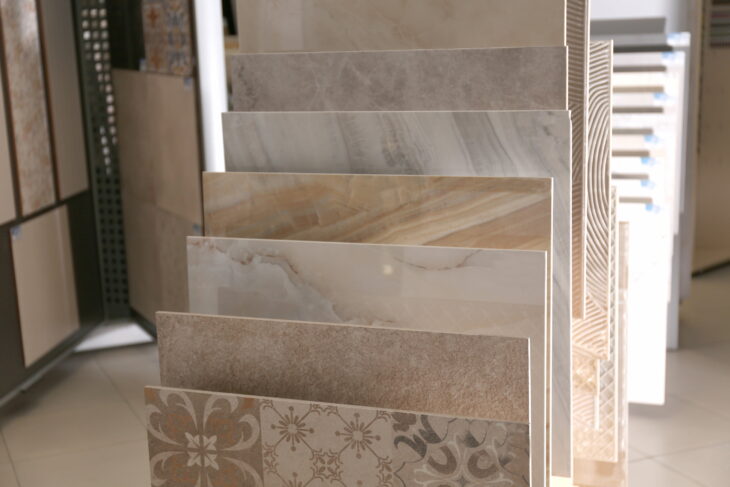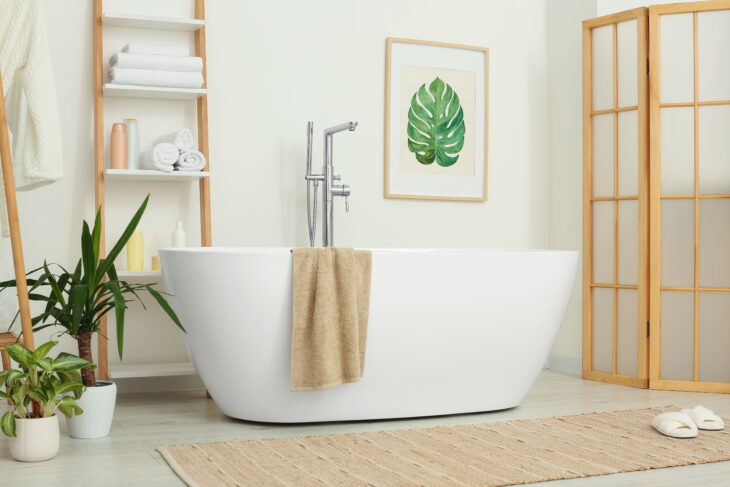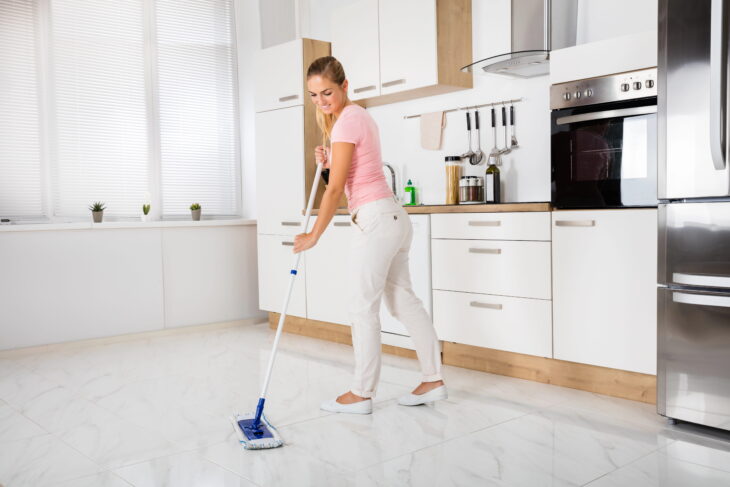Disclosure: Articles may contain affiliate links. As an Amazon Associate, we earn from qualifying purchases (at no additional cost to you). See our full disclosure here.
Last updated on March 29th, 2024 at 03:05 pm
The right tiles can totally transform a home! They’re not just durable and attractive, but super functional too. However, in kitchens, bathrooms, and outdoor spaces they can also be a bit risky.
Accidents caused by slippery tiles can cause significant injuries, so it’s absolutely essential to take some precautions to minimize the risk. You want to ensure your tiles are an asset to your home–not an accident waiting to happen.
So, if you’re wondering how to make tile floors less slippery, keep reading. We’re sharing five tips that can help prevent your home’s tiles from becoming a hazard.

How to Make Tile Floors Less Slippery
Choose Non-Slip Tiles
First up, and maybe most obviously, the best way to make your tile floor less slippery is to install non-slip tiles.
These days you’ll find a variety of non-slip tiles in several different materials. For example, many high-quality porcelain tiles are non-slip these days, and they’re especially useful for areas of the home that are often exposed to moisture, like bathrooms and kitchens.
Keep an eye out for slip resistance ratings on tiles. Look for classifications like R9, R10, or R11, which are among the highest-rated for providing additional grip and traction, ensuring a safer environment for you and your loved ones.
Apply Anti-Slip Treatments
Of course, if you already have tile floors and want to make them less slippery, you need another solution. In this case, you can add your own anti-slip treatment.
Luckily, there are a range of products on the market to choose from. These anti-slip treatments are chemical solutions that create a rougher surface on the tile which can enhance grip.
Before applying an anti-slip treatment, you’ll need to thoroughly clean the tiles to remove any dirt, grime, or residue that may affect how well the treatment adheres. Follow the manufacturer’s instructions carefully, and apply the treatment evenly across the tile surface using a brush, roller, or sprayer. Allow the treatment to dry completely before allowing anyone to walk on the treated area.

Use Slip-Resistant Mats or Rugs
One of the more common (and easiest) methods of avoiding accidents is to add non-slip rugs or mats in areas of high traffic on your tile flooring, particularly around entryways.
You can also add non-slip rugs to areas that tend to get wet, like around showers, sinks and bathtubs.
They can not only help prevent accidents but also be an additional way to decorate the room, adding a new dimension to your flooring. You’ll find many retailers like IKEA, Wayfair, and Amazon selling anti-slip rugs these days.

Keep Tiles Clean and Dry
One of the simplest, but most important, ways to prevent tiles from becoming slippery is to keep them clean and dry. Dirt, soap, grease, and other residue can accumulate on your flooring surfaces, increasing the risks of slipping, so sticking to a regular cleaning routine can help keep those risks to a minimum.
Quickly cleaning up any spills or water on tile floors is important. And, of course, be sure to let water or cleaning products dry before stepping onto wet floor tiles.
Install Grab Bars and Handrails
Finally, if there are people in the home who already have mobility issues, installing grab bars and handrails may be a good option. While not limited to people with these issues, adding safety features like these can provide additional support and stability, allowing for safer navigation of wet or slippery surfaces.
The bathroom is the natural location for grab bars and handrails, as well as in outside areas where the weather can make tiles slippery. This is a simple, but crucial way to prevent a significant number of falls and injuries, which can often be serious.
Wrapping Up
To wrap up, ensuring your floors are safe is part of creating a comfortable home. By choosing non-slip tiles, applying anti-slip treatments, incorporating slip-resistant mats or rugs, keeping tiles clean and dry, and installing grab bars and handrails where necessary, you can significantly reduce the risk of accidents caused by slippery tiles.
Remember, it’s not just about aesthetics; it’s about creating a space where you and your loved ones can move around confidently and safely. So, take these precautions to heart, and enjoy your beautiful tiled spaces without worry!
Also read:
Bathroom Renovation on a Budget: 6 Ways to Save
Can you Renovate Your Kitchen on a Budget? 9 Tips for an Affordable Revamp
Give Your House a Facelift: 6 Smart Ways to Update the Exterior of Your Home
You can also find MomsWhoSave on Pinterest, Facebook, Instagram, and Twitter. Join us for updates.
Leave a Reply